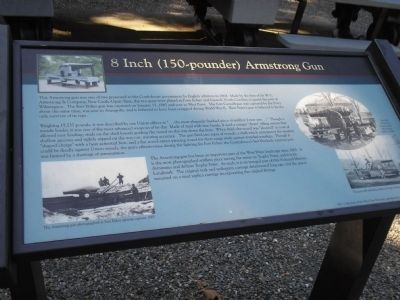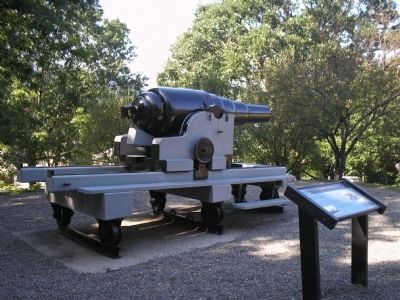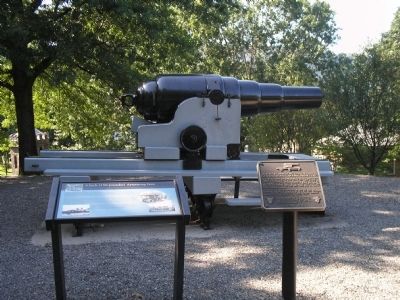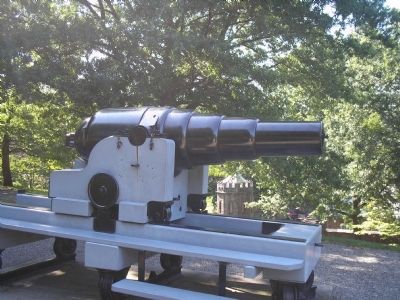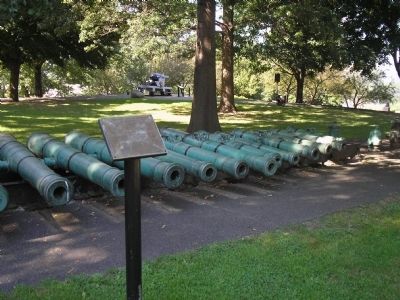West Point in Orange County, New York — The American Northeast (Mid-Atlantic)
8 Inch (150-pounder) Armstrong Gun
Weighing 15,737 pounds, it was described by one Union officer as “ . . . the most elegantly finished piece of artillery I ever saw . . . ” Though a muzzle loader, it was one of the most advanced weapons of its day. Made of steel with iron bands, it used a unique “shunt” rifling system that allowed easy loading; studs on the shell loosely guiding the round on the way down the bore. When fired, the round was “shunted” to a set of shallow grooves and tightly nipped on the way out, insuring accuracy. The gun fired two types of rounds; a shell which anticipated the modern “shaped charge” with a heat activated fuze, and a flat nosed armor piercing round for short range work against ironclad warships. Though it could be deadly against Union vessels, the gun’s effectiveness during the fighting for Fort Fisher, the Confederacy’s last blockade running port, was limited by a shortage of ammunition.
The Armstrong gun has been an important part of the West Point landscape since 1865. It is the most photographed artillery piece among the many on Trophy Point, and it both dominates and defines Trophy Point. As such, it is an integral part of this National Historic Landmark. The original teak and mahogany carriage deteriorated long ago, and the gun is mounted on a steel replica carriage incorporating the original fittings.
Topics. This historical marker is listed in this topic list: War, US Revolutionary. A significant historical month for this entry is January 1922.
Location. 41° 23.676′ N, 73° 57.5′ W. Marker is in West Point, New York, in Orange County. Marker can be reached from Washington Road, on the right when traveling west. Marker is located at Trophy Point in the United States Military Academy. Touch for map. Marker is in this post office area: West Point NY 10996, United States of America. Touch for directions.
Other nearby markers. At least 8 other markers are within walking distance of this marker. 150 Pounder Armstrong Gun Captured at Fort Fisher, North Carolina – January 15, 1865 (here, next to this marker); Battery Sherburne (within shouting distance of this marker); Douglas MacArthur (within shouting distance of this marker); Welcome to Trophy Point (within shouting distance of this marker); U.S. Military Academy (within shouting distance of this marker); Wars That Shaped the Nation (within shouting distance of this marker); Ulysses S. Grant (about 300 feet away, measured in a direct line); Beat Navy Tunnel (about 400 feet away). Touch for a list and map of all markers in West Point.
More about this marker. A recent picture of the Armstrong Gun appears on the top left of the marker. The bottom left of the marker features The Armstrong gun photographed at Fort Fisher upon its capture – 1865. The right of the marker contains old photos of the weapon at Trophy Point in 1865 or 1866, and of cadets posing by the gun on Trophy Point.
Credits. This page was last revised on June 16, 2016. It was originally submitted on September 8, 2009, by Bill Coughlin of Woodland Park, New Jersey. This page has been viewed 2,278 times since then and 81 times this year. Photos: 1, 2, 3, 4, 5. submitted on September 8, 2009, by Bill Coughlin of Woodland Park, New Jersey.
